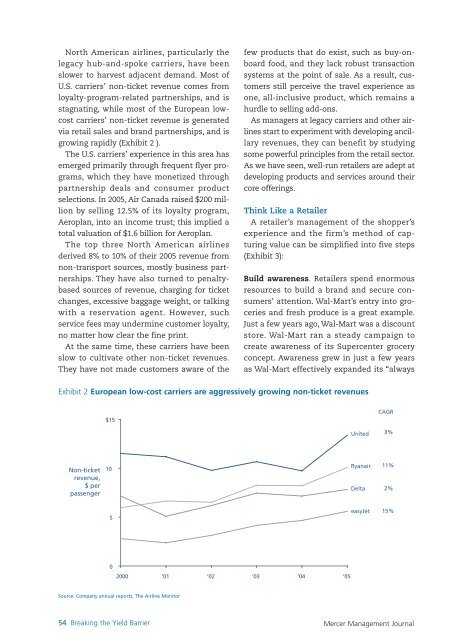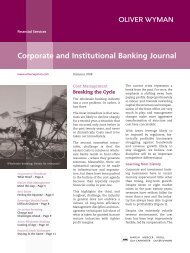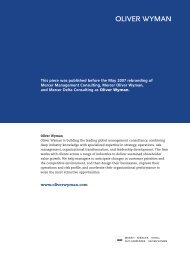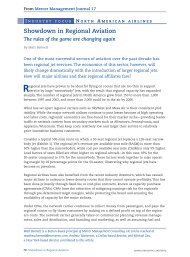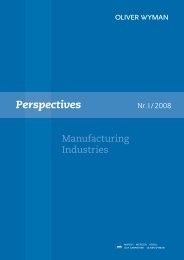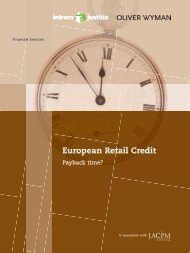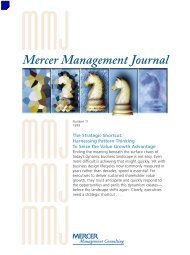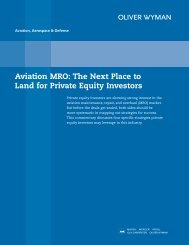This piece was published before the May 2007 ... - Oliver Wyman
This piece was published before the May 2007 ... - Oliver Wyman
This piece was published before the May 2007 ... - Oliver Wyman
You also want an ePaper? Increase the reach of your titles
YUMPU automatically turns print PDFs into web optimized ePapers that Google loves.
North American airlines, particularly <strong>the</strong><br />
legacy hub-and-spoke carriers, have been<br />
slower to harvest adjacent demand. Most of<br />
U.S. carriers’ non-ticket revenue comes from<br />
loyalty-program-related partnerships, and is<br />
stagnating, while most of <strong>the</strong> European lowcost<br />
carriers’ non-ticket revenue is generated<br />
via retail sales and brand partnerships, and is<br />
growing rapidly (Exhibit 2 ).<br />
The U.S. carriers’ experience in this area has<br />
emerged primarily through frequent flyer programs,<br />
which <strong>the</strong>y have monetized through<br />
partnership deals and consumer product<br />
selections. In 2005, Air Canada raised $200 million<br />
by selling 12.5% of its loyalty program,<br />
Aeroplan, into an income trust; this implied a<br />
total valuation of $1.6 billion for Aeroplan.<br />
The top three North American airlines<br />
derived 8% to 10% of <strong>the</strong>ir 2005 revenue from<br />
non-transport sources, mostly business partnerships.<br />
They have also turned to penaltybased<br />
sources of revenue, charging for ticket<br />
changes, excessive baggage weight, or talking<br />
with a reservation agent. However, such<br />
service fees may undermine customer loyalty,<br />
no matter how clear <strong>the</strong> fine print.<br />
At <strong>the</strong> same time, <strong>the</strong>se carriers have been<br />
slow to cultivate o<strong>the</strong>r non-ticket revenues.<br />
They have not made customers aware of <strong>the</strong><br />
few products that do exist, such as buy-onboard<br />
food, and <strong>the</strong>y lack robust transaction<br />
systems at <strong>the</strong> point of sale. As a result, customers<br />
still perceive <strong>the</strong> travel experience as<br />
one, all-inclusive product, which remains a<br />
hurdle to selling add-ons.<br />
As managers at legacy carriers and o<strong>the</strong>r airlines<br />
start to experiment with developing ancillary<br />
revenues, <strong>the</strong>y can benefit by studying<br />
some powerful principles from <strong>the</strong> retail sector.<br />
As we have seen, well-run retailers are adept at<br />
developing products and services around <strong>the</strong>ir<br />
core offerings.<br />
Think Like a Retailer<br />
A retailer’s management of <strong>the</strong> shopper’s<br />
experience and <strong>the</strong> firm’s method of capturing<br />
value can be simplified into five steps<br />
(Exhibit 3):<br />
Build awareness. Retailers spend enormous<br />
resources to build a brand and secure consumers’<br />
attention. Wal-Mart’s entry into groceries<br />
and fresh produce is a great example.<br />
Just a few years ago, Wal-Mart <strong>was</strong> a discount<br />
store. Wal-Mart ran a steady campaign to<br />
create awareness of its Supercenter grocery<br />
concept. Awareness grew in just a few years<br />
as Wal-Mart effectively expanded its “always<br />
Exhibit 2 European low-cost carriers are aggressively growing non-ticket revenues<br />
$15<br />
CAGR<br />
United<br />
3%<br />
Non-ticket<br />
revenue,<br />
$ per<br />
passenger<br />
10<br />
Ryanair<br />
Delta<br />
11%<br />
2%<br />
5<br />
easyJet<br />
15%<br />
0<br />
2000 ‘01 ‘02 ‘03 ‘04 ‘05<br />
Source: Company annual reports, The Airline Monitor<br />
54 Breaking <strong>the</strong> Yield Barrier<br />
Mercer Management Journal


